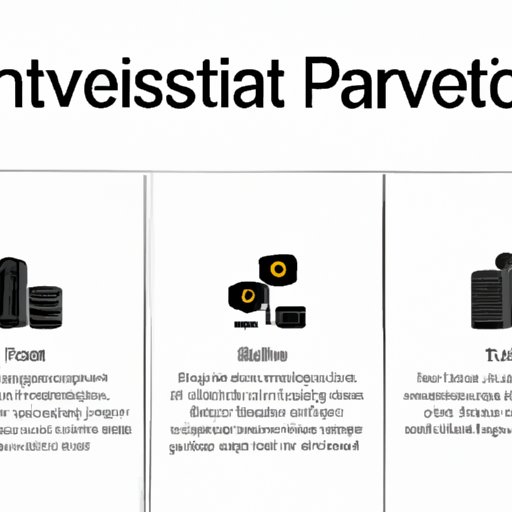Introduction
Passive investing is an investment strategy that involves buying and holding securities over the long-term in order to maximize returns. It is a relatively low-cost and low-risk approach to investing that has become increasingly popular over the last few decades.
The purpose of this article is to explore what passive investing is, how it works, the benefits and drawbacks of this approach, as well as provide a guide on how to get started. We will also discuss the different types of passive investments available, strategies for building a successful portfolio, and how to avoid common mistakes. Finally, we will evaluate the risk vs. reward of passive investing.
Exploring the Basics of Passive Investing
Passive investing is an investment strategy that seeks to generate returns by buying and holding securities over the long-term. This approach typically involves investing in a broad range of assets such as stocks, bonds, and real estate, rather than actively trading individual stocks. The goal of passive investing is to generate consistent returns with minimal effort and cost.
What is Passive Investing?
Passive investing is an investment strategy that uses index funds, ETFs, and mutual funds to purchase a variety of assets. This approach does not involve active stock picking or trading, but instead relies on the market’s overall performance to generate returns. By investing in a wide range of assets, investors can diversify their portfolios and reduce their risk exposure.
What are the Different Types of Passive Investing?
There are several different types of passive investing, including index funds, exchange traded funds (ETFs), and mutual funds. Index funds and ETFs are baskets of securities that track a specific market index, such as the S&P 500. Mutual funds are managed funds that invest in a variety of assets, such as stocks, bonds, and cash equivalents.
How Does Passive Investing Work?
Passive investing works by taking advantage of the natural fluctuations of the market. As markets rise and fall, so do the values of the securities held in a portfolio. By investing in a wide range of assets, investors can diversify their portfolios and reduce their risk exposure. Over time, this approach can help investors achieve higher returns with less effort than active investing.

The Benefits and Drawbacks of Passive Investing
Passive investing offers many advantages over active investing, including lower costs, less volatility, and greater diversification. However, there are also some drawbacks to consider, such as the potential for underperformance and lack of control over the portfolio.
Benefits of Passive Investing
The primary benefit of passive investing is its low cost. According to a study from Fidelity Investments, “the average expense ratio for actively managed mutual funds was 0.67%, compared to just 0.09% for passively managed index funds.” Additionally, passive investing is less volatile than active investing, which can help investors stay disciplined and focused on their long-term goals.
Another advantage of passive investing is the ability to diversify a portfolio. By investing in a variety of different asset classes, investors can spread out their risk and reduce their exposure to any single security or sector. This can help to ensure that a portfolio remains balanced and resilient over time.
Drawbacks of Passive Investing
One of the main drawbacks of passive investing is the potential for underperformance. Since passive investments are designed to match the market’s performance, they may not be able to keep up with more aggressive investments in times of high growth. Additionally, investors have no control over the investments they make, which can lead to missed opportunities.
Another potential downside of passive investing is the lack of tax efficiency. Since passive investments are held for long periods of time, investors may be subject to capital gains taxes when they sell. This can significantly reduce returns, so it’s important for investors to understand the tax implications of their investments.

A Guide to Getting Started with Passive Investing
Getting started with passive investing doesn’t have to be complicated. Here are a few steps to help you get started:
Establishing Your Investment Goals
The first step to getting started with passive investing is to establish your investment goals. Consider your current financial situation, as well as your long-term goals. This will help you determine the type of investments that are right for you.
Choosing a Brokerage or Investment Platform
Once you have established your investment goals, the next step is to choose a brokerage or investment platform. There are many options available, so take the time to research the fees, commissions, and services offered by each one. Make sure to compare multiple platforms before making a decision.
Decide How Much to Invest
Before investing, it’s important to decide how much you can afford to invest. Consider your income, savings, and other financial commitments to determine how much you can realistically set aside for investing. It’s also important to remember that investing is a long-term commitment, so make sure you’re comfortable with the amount you’re investing.
Selecting the Right Investments
Once you’ve decided how much to invest, it’s time to select the right investments. Take the time to research different types of investments, and consider factors such as risk tolerance, time horizon, and return objectives. It’s also important to diversify your portfolio, so make sure to include a variety of asset classes in your investments.

Understanding the Different Types of Passive Investing
There are several different types of passive investing, each with its own unique characteristics. Let’s take a look at some of the most popular types of passive investing.
Index Funds
An index fund is a type of mutual fund that tracks a specific market index, such as the S&P 500. These funds are designed to replicate the performance of the underlying index. They are typically low-cost investments, and can be a good choice for investors who want a simple, low-maintenance way to invest.
Exchange Traded Funds (ETFs)
Exchange traded funds (ETFs) are similar to index funds, but they are traded on exchanges like stocks. ETFs can offer investors access to a wide range of assets, including stocks, bonds, commodities, and currencies. They are also typically low-cost investments, and can be a good choice for investors who want to diversify their portfolios without the hassle of actively managing their investments.
Mutual Funds
Mutual funds are professionally managed funds that invest in a variety of assets, such as stocks, bonds, and cash equivalents. These funds are designed to generate returns for investors over the long-term. Mutual funds can be a good choice for investors who want to diversify their portfolios and minimize their risk exposure.

Strategies for Building a Successful Passive Investing Portfolio
Building a successful passive investing portfolio requires careful planning and regular monitoring. Here are a few tips to help you get started:
Diversify Your Portfolio
It’s important to diversify your portfolio to reduce your risk exposure. Consider investing in a variety of asset classes, such as stocks, bonds, and real estate. This will help to ensure that your portfolio remains balanced and resilient over time.
Rebalance Regularly
As markets fluctuate, it’s important to regularly rebalance your portfolio to maintain your desired level of risk. This means periodically selling off some of your winning investments and buying more of your losing investments. Doing so will help to ensure that your portfolio remains aligned with your investment goals.
Monitor Your Investments
Finally, it’s important to monitor your investments to ensure that they remain on track. Pay close attention to changes in the markets, and make adjustments as necessary. This will help to ensure that your portfolio remains aligned with your investment goals.
How to Avoid Common Mistakes in Passive Investing
Although passive investing can be a great way to generate returns, there are some common mistakes that investors should be aware of. Here are a few tips to help you avoid these mistakes:
Not Doing Enough Research
It’s important to do your due diligence before investing in any security. Take the time to research the company, read analyst reports, and understand the risks involved. Doing so will help to ensure that you are making informed decisions about your investments.
Not Keeping Up With Tax Laws
Taxes can have a significant impact on your returns, so it’s important to stay up to date on the latest tax laws. Make sure to consult a financial advisor to ensure that you are taking full advantage of any available tax breaks and deductions.
Not Taking Advantage of Tax-Advantaged Accounts
Tax-advantaged accounts, such as 401(k)s and IRAs, can be great tools for passive investors. Make sure to take advantage of these accounts to maximize your returns and reduce your tax burden.
Evaluating the Risk vs. Reward of Passive Investing
When evaluating the risk vs. reward of passive investing, it’s important to consider your risk tolerance and return objectives. Here are a few tips to help you make an informed decision:
Assessing Your Risk Tolerance
It’s important to assess your risk tolerance before investing. Consider your financial goals, time horizon, and comfort level with risk. This will help you determine the types of investments that are right for you.
Calculating Your Return on Investment
It’s also important to calculate your return on investment (ROI). Consider the expected return of the investments you are considering, as well as any associated fees or taxes. This will help you determine whether the investments are worth the risk.
Conclusion
Passive investing is an investment strategy that seeks to generate returns by buying and holding securities over the long-term. This approach typically involves investing in a broad range of assets, such as stocks, bonds, and real estate, rather than actively trading individual stocks. The benefits of passive investing include lower costs, less volatility, and greater diversification. However, there are also some drawbacks to consider, such as the potential for underperformance and lack of control over the portfolio.
To get started with passive investing, it’s important to establish your investment goals, choose a brokerage or investment platform, decide how much to invest, and select the right investments. It’s also important to understand the different types of passive investing, such as index funds, ETFs, and mutual funds. Finally, it’s important to assess your risk tolerance and calculate your return on investment to ensure that your investments are aligned with your goals.
By following these tips, you can increase your chances of success with passive investing. With patience and discipline, you can achieve your long-term investment goals.
(Note: Is this article not meeting your expectations? Do you have knowledge or insights to share? Unlock new opportunities and expand your reach by joining our authors team. Click Registration to join us and share your expertise with our readers.)
